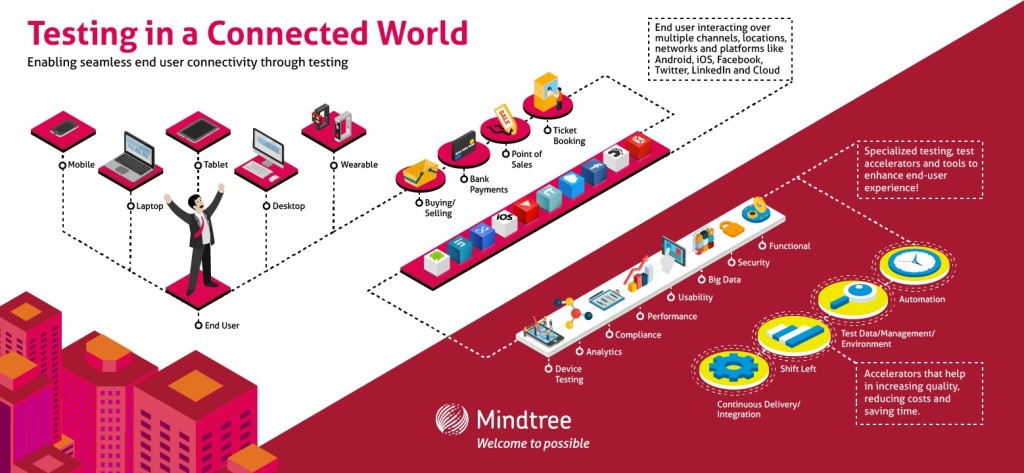In today’s world driven by technology and the Internet of Things (IoT), testing new products is more complex than ever. The process can prove to be long and costly for IT organizations as the increasing number of mobile devices, smart appliances, media channels, developmental environments, and business applications need to achieve faultless connectivity.
While the focus has been on global delivery models and right shoring, to systematize Quality Assurance (QA) and testing into centralized and decentralized hybrid teams, companies now need:
- A continuous delivery platform that integrates test-ops and design and maps to model-based testing
- Service virtualization
- Clearly defined target operating models
This new approach, focused on digital experiences and agility, will enable companies to get products to market faster while addressing quality, automation and predictability.
Digital disruption is real and it’s here
In today’s connected world where social channels are integral to consumers, the reaction time for businesses is evaporating quickly. Organizations have to embrace the power of consumers as a driving force for business strategy which unifies customer engagement channels, supply chains, interfacing devices and application touch points. Quality assurance organizations need to assess their customer experience capabilities, as well as ensure the functionality of each individual application by introducing developmental quality, cost and agility.
As business outlooks shift focus to the disruptive nature of digital technologies, organizations need to create differentiation in their traditional scale-driven testing offerings. They must come up with innovative digital inputs and invest in digital platforms that feature an integrated test delivery platform, omni-channel test automation frameworks, mobile testing strategies, and crowd testing.
The paradigm shift to mobile testing is essential, but it is not just about rendering applications to mobile devices. Testing strategies should focus on empowering users, especially the on-the-move users. It is vital for applications to be tested on numerous operating systems and devices in different geographies. Such testing cannot be done on premises and must be done in the cloud. Effective mobile application testing now require cloud-based mobile test automation tools that use real devices as opposed to emulators.
Agile delivery models integrating both upstream and downstream
As companies now expect to introduce products into the market within weeks, a crucial step for successful integration in a digital world is to reduce test cycle time by adopting a dynamic test engineering platform. This means fast, responsive QA and testing solutions integrated with agile development.
Companies need to stop the one-way upstream integration, instead integrate it with a downstream approach to create a new Test-Ops concept which is collaborative, iterative, and fosters open communication and healthy interactions.
To conclude, it is critical to move toward Test Ops, the Quality Assurance and Testing aspects of Development Operations (Test Environment Management, Environment Scheduling, Provisioning and Retrofit, Automated Build/Deployment and Test Data Management) . These help in enabling Continuous Integration and improve software quality and speed of delivery.
In a connected world, competition is rapidly increasing, choosing the right testing partner can mean the difference between success and failure. Identifying the best practices ensures that products and applications are ready by deadlines and meet customer expectations; ensuring companies deliver defect-free products and services for a quantifiable return on investment.
This post is by EuroSTAR 2015 Gold Partner MindTree.
